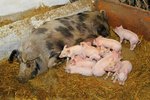
Although polar bears (Ursus maritimus) are undeniably massive animals, their typical gestation lengths are shorter than those of human beings. Female polar bears typically reproduce in intervals of two years or so. These furry white Arctic residents often give birth to twins, although not in all cases.
Delayed Implantation
The reproductive season of polar bears typically begins in April and ends in June each year. After fertilization occurs, egg implantation doesn't happen immediately. The process waits until the mother bear's body is fully prepared to get through not only winter hibernation, but also pregnancy, birthing and rearing the youngsters. When she has sufficient weight on her body, she's usually good to go. This generally happens at the end of September.
Length of Pregnancy
Once implantation happens, gestation lasts for roughly three months, and they welcome their offspring sometime between December and January. Although gestation technically only lasts for a couple months, the entire process, delayed implantation included, takes around eight months.
Offspring
Although polar bear mothers often have twins, their litters can consist of solo clubs or as many as four little guys. Female polar bears set up dens in which to birth their litters. This usually happens from October to November. Mother polar bears typically reside in the dens until springtime is near or has arrived, whether in February, March or April. At birth, the cubs' eyes are shut and they usually weigh just a little less than 24.5 ounces. Females assume full responsibilities for raising the youngsters. They generally nurse their cubs until they're between 18 and 30 months in age, when weaning occurs. Juveniles usually live alongside their mothers until they reach 2 to 3 years in age.
Benefit of Delayed Implantation
Delayed implantation has a point beyond just making pregnancy officially start at a later date. The goal of the process is actually a sensible one -- to allow polar bear youngsters to start their lives in an optimal period for staying strong and thriving, seasonally speaking. Delayed implantation also gives female polar bears more time to prepare for carrying and nourishing their future offspring.
References
- University of Michigan Animal Diversity Web: Ursus Maritimus
- IUCN Red List of Threatened Species: Ursus Maritimus
- Smithsonian National Museum of Natural History: Ursus Maritimus
- NatureWorks: Polar Bear
- Association of Zoos & Aquariums: Polar Bear (Ursus maritimus) Care Manual
- Point Defiance Zoo & Aquarium: Polar Bear (Ursus Maritimus)
- Defenders of Wildlife: Polar Bear
- Denver Zoo: Polar Bear
- SeaWorld Animal Bytes: Polar Bear
- SeaWorld: Polar Bears
Photo Credits
-
Comstock Images/Comstock/Getty Images



